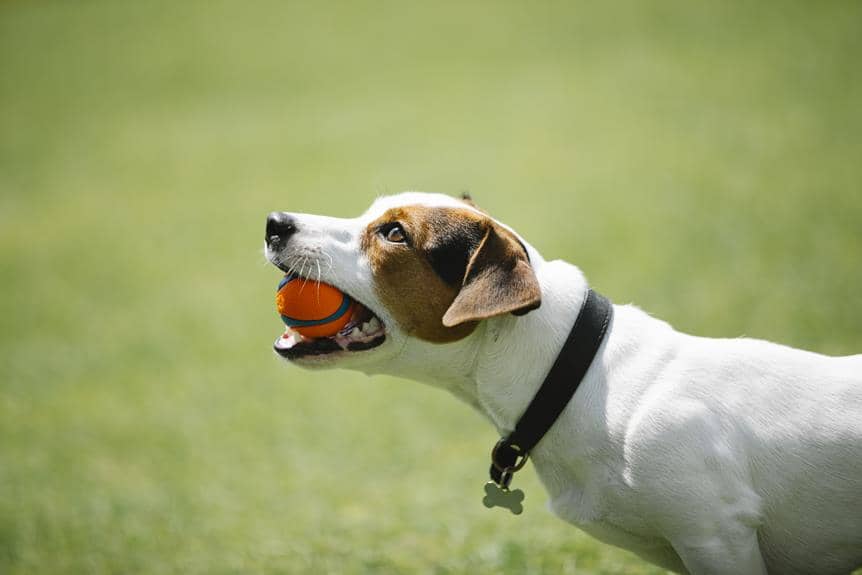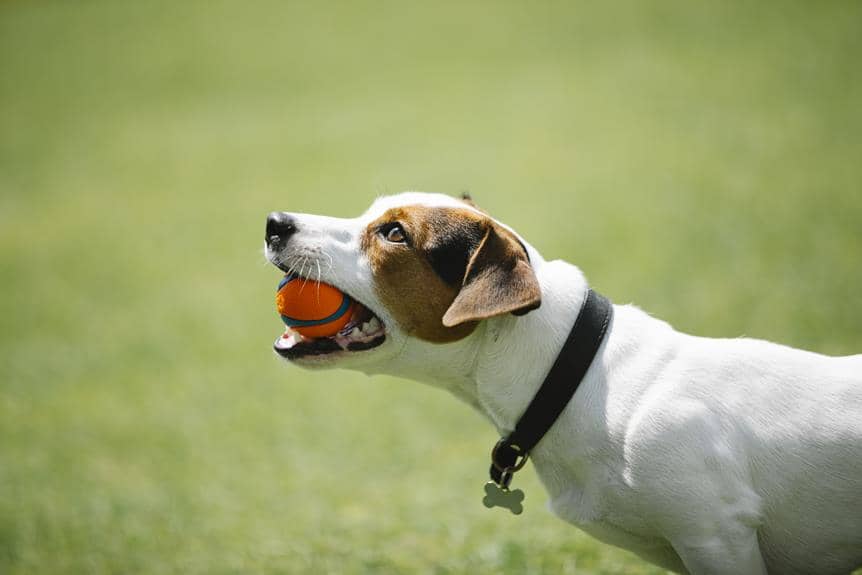
We’ve all been there – trying to figure out what type of collar Is best for dog training.
Well, here’s a surprising statistic: 90% of dog owners struggle with finding a suitable training collar.
But fear not! In this article, we’ll break down the different types of collars, from martingale to head halters and even prong collars.
We’ll also explore the benefits of using harnesses for training.
So, let’s dive in and discover which collar is best for your canine companion.
Table of Contents
Key Takeaways
- Martingale collars provide better control over dogs during walks and prevent them from slipping out, ensuring their safety.
- Head halters are a versatile and comfortable option that discourages pulling behavior and reduces the risk of injury to the dog’s neck and throat.
- Prong collars, when used correctly and with professional guidance, can be effective in certain situations but should always prioritize the well-being and comfort of the dog.
- Harnesses are a safer option for dogs with respiratory issues or prone to neck injuries, and they distribute pulling force across the chest and shoulders, discouraging pulling behavior and allowing for better communication and focus.
Different Types of Dog Training Collars
We prefer using the different types of dog training collars to effectively train our dogs. When training our furry friends, we understand that not all dogs respond to the same methods. That’s why having a variety of training collars is essential for us.
One type of training collar we find effective is the flat collar. It’s a basic collar made of nylon or leather that sits comfortably around our dog’s neck. This collar is perfect for everyday use and helps us control our dogs during walks or outings. It also provides a place to attach identification tags, ensuring their safety.
Another type of training collar we use is the martingale collar. This collar is designed to prevent our dogs from slipping out of it while still providing comfort. The martingale collar is handy for dogs that tend to pull on the leash during walks. It gives us better control over their movements without causing any harm.
Lastly, the head halter is an excellent training collar for dogs that need extra guidance. This collar gently redirects our dog’s attention towards us, making it easier to correct unwanted behaviors. It’s important to note that the head halter should be used cautiously and under proper guidance to avoid discomfort or harm to our dogs.
Pros and Cons of Martingale Collars
After researching the pros and cons of martingale collars, we’ve discovered that they offer increased control during walks and prevent dogs from slipping out. Still, we may also require proper fitting to avoid discomfort.
Here are three essential things to consider when it comes to martingale collars:
- Control: Martingale collars are designed to provide better control over your dog during walks. The adjustable loop tightens when the dog pulls, preventing them from slipping out of the collar. This added control can be handy for dogs that tend to pull or have a strong prey drive.
- Safety: One of the main advantages of martingale collars is their ability to prevent dogs from slipping out. The loop design ensures the collar stays secure, reducing the risk of your dog escaping and getting lost or injured.
- Proper Fitting: Ensuring that the martingale collar fits your dog correctly is crucial. A loose collar may not provide the desired control, while a collar that’s too tight can cause discomfort and potentially harm your dog. Take the time to accurately measure your dog’s neck and adjust the collar accordingly to ensure a snug but comfortable fit.
Considering these factors, martingale collars can be a valuable tool for dog owners who prioritize control and safety during walks. However, finding the right fit is essential to ensure your dog’s comfort and well-being.
Exploring the Benefits of Head Halters
Using head halters can provide both control and comfort for dogs during walks, helping prevent pulling and promoting positive training. Head halters are designed to fit over a dog’s muzzle and attach to the leash under the chin. This design allows for more control over the dog’s head and, subsequently, their body. Head halters can effectively discourage pulling behavior by gently redirecting the dog’s attention and guiding their movements. This makes walks more enjoyable for both the dog and the owner, teaches the dog proper leash manners, and reinforces positive training.
One of the main benefits of head halters is that they don’t put pressure on the dog’s neck or throat. Unlike traditional collars or harnesses, head halters distribute the force of the leash across the dog’s head and neck, reducing the risk of injury. This is especially important for dogs with respiratory issues, neck injuries, or brachycephalic breeds with short muzzles. Additionally, head halters can be adjusted to fit snugly without causing discomfort or restricting the dog’s natural movements.
Another advantage of head halters is their versatility. They can be used for dogs of all sizes and breeds, from tiny Chihuahuas to enormous Great Danes. They also work well for dogs who tend to lunge, bark, or show aggressive behavior toward other dogs or people. The gentle control provided by the head halter allows the owner to redirect the dog’s attention and maintain a safe distance, ensuring the well-being of everyone involved.
Understanding the Effectiveness of Prong Collars
Our research discovered that although prong collars are controversial, some trainers believe they can be effective when used correctly and in conjunction with positive reinforcement techniques. We understand this topic can be sensitive, as many people strongly oppose using prong collars. However, presenting a balanced perspective and acknowledging that some trainers find them useful in certain situations is important.
Here are three points to consider when discussing the effectiveness of prong collars:
- Proper fit: A prong collar should be fitted correctly to ensure it isn’t causing discomfort or harm to the dog. It should be snug but not too tight, allowing the prongs to contact the dog’s neck without causing pain.
- Training technique: Prong collars should always be used with positive reinforcement techniques. It’s essential to reward the dog for desired behaviors and gradually reduce the reliance on the collar as the dog becomes more responsive to commands.
- Professional guidance: It’s crucial to seek guidance advice from a professional dog trainer experienced in using prong collars. They can teach you the correct usage and advise you when and how to transition to other training tools.
While prong collars may have their place in certain specific training scenarios, it’s essential to prioritize the well-being and comfort of our furry friends.
Harnesses for Dog Training: What You Need to Know
Before we continue discussing prong collars, let’s explore the benefits and considerations of using harnesses for dog training.
Harnesses have recently gained popularity as an alternative to traditional collars for training purposes. One of the main benefits of using a harness is that it reduces the strain on a dog’s neck and distributes the pulling force across their chest and shoulders. This can be especially beneficial for dogs with respiratory issues or those prone to neck injuries. Additionally, harnesses provide better control and prevent choking or gagging, making them safer for dogs who tend to pull on the leash.
Another advantage of using a harness is that it discourages pulling behavior. Harnesses are designed to prevent dogs from pulling by redirecting their attention towards the handler. This can be particularly useful for training sessions and walks, allowing for better communication and focus between the dog and the handler. Furthermore, harnesses are often recommended for smaller breeds or dogs with delicate necks, as they provide extra support and prevent injury during training exercises.
However, there are also some considerations to consider when using a harness. Some dogs may find the feeling of a harness uncomfortable or restrictive, especially if they aren’t used to wearing one. Introducing the harness gradually and ensuring a proper fit is essential to avoid discomfort. Additionally, some harnesses may not be suitable for certain types of training, such as protection work or agility training, where a prong collar or a different type of collar may be more appropriate.
Frequently Asked Questions
Are Shock Collars Safe to Use for Dog Training?
Shock collars can be effective, but there are risks involved. Using them responsibly and under a professional trainer’s guidance is essential to ensure the dog’s safety and well-being.
Can Using a Prong Collar Harm My Dog’s Neck or Cause Injury?
Using a prong collar for dog training can harm the dog’s neck and cause injury. Considering alternative training methods that prioritize the dog’s safety and well-being is important.
Is It Possible to Train a Dog Without Using Any Type of Collar?
Yes, training a dog without using any type of collar is possible. Positive reinforcement methods, such as clicker training and treats, can effectively teach dogs without needing physical correction.
Are Head Halters Suitable for All Dog Breeds and Sizes?
Head halters can be suitable for all dog breeds and sizes, but it’s crucial to consider individual temperament and comfort. They provide control and redirect pulling, making them a popular choice for leash training.
What Are the Potential Risks or Drawbacks of Using a Harness for Dog Training?
When using a harness for dog training, potential risks or drawbacks may include limited control over the dog’s movements and the possibility of the dog pulling more due to the lack of pressure on the neck.
Conclusion
Overall, there are various types of collars and harnesses available for dog training, each with their own pros and cons. multiple types of collars and harnesses are available for dog training, each with
However, one interesting statistic to note is that according to a study conducted by the University of Pennsylvania School of Veterinary Medicine, head halters have been found to significantly reduce pulling behavior in dogs by an average of 78%.
This makes head halters a promising tool for dog owners looking to train them to walk calmly on a leash.








Leave a Reply
You must be logged in to post a comment.